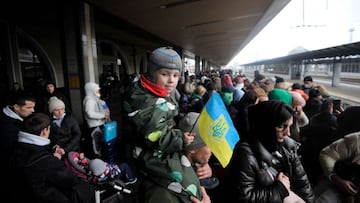Has Moscow announced a new ceasefire this week?
President Putin continues to bombard Ukrainian cities with artillery and the much-vaunted 'humanitarian corridors' offered by Moscow lead towards Russia.


As Russian attacks on major Ukrainian cities continue, Moscow has announced the introduction of limited ‘humanitarian corridors’ to allow civilians to leave.
Moscow has refused to agree to a ceasefire with Ukraine during the three peace negotiations that have taken place in the 12 days since the invasion began. Even after the safe corridors were announced the Russian military continues to bombard cities and slaughter civilians.
Hundreds of thousands of civilians are attempting to flee to safety but have seen their passage disrupted by sustained shelling from Russian forces and there is uncertainty about what awaits them at the end of their journey.
Related news:
- US imports from Russia and Ukraine hit by sanctions
- War in Ukraine to hammer global food supplies
- US gasoline prices soar due to Russian invasion
What are humanitarian corridors?
On Monday the humanitarian crisis in Ukraine worsened as Moscow intensified the military action on Ukraine, targeting major cities with prolonged and indiscriminate bombings. The situation on the ground is becoming increasingly bleak with supplies of food, water and medicine reportedly running out in certain areas.
In this context officials from Russia and Ukraine attended a third round of talks on Monday but were unable to agree to any significant ceasefire. Instead Russia agreed to establish humanitarian corridors, also known as safe corridors, to allow civilians to escape the conflict and head to neighbouring countries.
Russia shelled an evacuation route after opening "humanitarian corridors" for people to escape, says Ukraine.
— AJ+ (@ajplus) March 8, 2022
200,000 people have been trapped in Mariupol with no power or water for about a week, with food running low.
At least 1 child has died from dehydration, says Ukraine. pic.twitter.com/NGIuW6BVfe
However many of the evacuation routes for Ukrainians actually lead towards Russia or its Moscow-allied Belarus, meaning that there has been understandable reluctance to utilise them. Ukraine has criticised the move as an “immoral” stunt on the part of the Kremlin.
Humanitarian corridors are not easy to enforce during conflict
The notion of ‘humanitarian corridors’ was first publicised in the 1990s during the Bosnian War when the United Nations set up specific safe areas for civilians. Facing a European conflict on a scale not seen since World War Two, the UN now estimates that more than two million people have been forced to leave Ukraine during the first 12 days of the invasion.
However in the Bosnian conflict the UN struggled to protect the safe zones and that appears to be again. Reports suggest that Russian forces are not respecting the humanitarian corridors.
Ukraine’s UN Ambassador Sergiy Kyslytsya called it 'appalling' that Russian troops opened fire on evacuees after the two countries had reached an agreement to allow for humanitarian corridors pic.twitter.com/KJ2SfaTexP
— NowThis (@nowthisnews) March 7, 2022
Related stories
At The Hague, Netherlands a legal team representing Ukraine has pleaded with the International Court of Justice to order an end to Russia’s invasion, claiming that the Kremlin is committing war crimes for its sustained attack on civilian targets.
Jonathan Gimblett, a member of Ukraine’s legal team, said that Russia “is resorting to tactics reminiscent of medieval siege warfare, encircling cities, cutting off escape routes and pounding the civilian population with heavy ordnance.”

